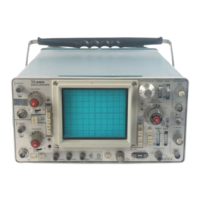I,
I.,
_-)
!.·
Circuit Description-465
from passing
to
the amplifier.
In
the
GND position, S5
opens
the
signal path
and
connects
the
input
of
the
amplifier
to
ground. This provides a
ground
reference
without
the
need to
disconnect
the
applied signal from
the
input
connector.
Resistor R4,
connected
across
the
input
coupling switch, allows
C3
to
be
pre-charged
in
the ground
position so
that
the
trace remains on screen when switched
to
the
AC
position.
Input Attenuator
The effective overall deflection factor
of
each channel
of
the
465
is
determined
by
the
appropriate
VOLT /DIV
switch. The basic deflection factor
of
the
Vertical Deflec-
tion System
is
5 m V /division
of
CRT
deflection. To achieve
the
deflection factor values indicated on
the
front
panel,
precision
attenuators
are switched
in
to
the
circuit and
the
gain
of
the
First Cascode Amplifier stage
is
changed.
For
the
VOLT/DIV switch positions above 5 mV,
attenuators
are switched
in
to
the
circuit, singly or
in
pairs,
to
help produce
the
vertical deflection factors indicated on
the
front
panel. These
attenuators
are frequency-
compensated voltage dividers.
In
addition
to
providing
constant
attenuation
at
all frequencies within
the
band-
width
of
the
instrument,
the
Input
Attenuators
are
designed to maintain
the
same
input
RC
characteristics
(1
MD
times
approximately
20
pF)
for each setting
of
the
VOLT /DIV switch. Each
attenuator
contains an adjustable
series capacitor
to
provide
correct
attenuation
at
high
frequencies and an adjustable
shunt
capacitor
to
provide
correct
input
capacitance.
NOTE
Each
attenuator
is
a hybrid encapsulated plug-in
assembly; therefore, replacement
of
individual com-
ponents within the attenuator
is
not
possible. Should
defects occur, the attenuator
must
be replaced
as
a
unit.
Scale-Factor Switching Circuit
The vertical deflection factor for each channel
is
indicated by back-lighting
the
appropriate
figures imprinted
on
the
flange
of
the
VOLTS/DIV
knob.
When a X 1 probe
is
connected
to
the
CH
1 OR X
input
connector,
the
base
level
of
transistor
0386
is
determined
by
the
voltage divider
composed
of
R384, R383 and X10 display factor bulb
DS382.
0386
is
biased
into
saturation
and
conducts
current
through
the
X1
indicator DS386. When
0386
conducts,
the
voltage level
at
its collector
is
very close
to
+5 volts.
Therefore,
there
is
insufficient bias
at
the
base
of
0382
to
cause
0382
to
conduct,
and
the
X10 indicator DS382
remains dark.
3-4
When a X10 probe with a scale factor switching
connector
is
attached
to
the
CH
1 OR X
input
connector,
the
base of
0382
is
returned
to
ground through R381.
0382
is
now biased
into
saturation
and conducts current
through X10 indicator DS382.
The
collector
level
of
0382
is
very close
to
+5 volts;
therefore,
there
is
insufficient bias
at
the
base
of
0386
to
cause
it
to
conduct
and X 1 indicator
DS386 remains dark.
Source Follower Stage
The Channel 1 signal from
the
Input
Attenuator
is
connected
to
the
Source Follower Stage through R 16 and
C16. R 15 provides
the
input
resistance for this stage. R 16
limits
the
current
drive
to
the
gate
of
O20A. Diode
CR
18
protects
the
circuit by clamping
the
gate
of
O20A
at
about
-8.7
volts
if
a high
amplitude
negative-going signal
is
applied
to
the
CH
1 OR X
input
connector.
O20B
is
a
relatively
constant
current
source for O20A.
First Cascade Amplifier Stage
The Paraphase Amplifier Stage
composed
of
032
and
036
converts
the
single-ended
input
signal into a push-pull
output
signal. C33, C34
and
CR34
optimize high frequency
response through
the
amplifier stage. R37 and R38 provide
thermal balance for
the
amplifier. C37 and C38 minimize
Miller
effect
through
032
and
036.
Step Atten
Bal
adjustment
R25 adjusts for
no
baseline shift of a CRT
display when switching between
adjacent
positions of the
VOLTS/DIV switch.
The Common Base Amplifier stage composed
of
042
&
044
converts
the
input
signal
currents
into
output
voltage
signals across load resistors R44 and R45. Correct vertical
deflection factors are
obtained
by
using a combination
of
attenuation
in
the
Input
Attenuator
Stage and changing
the
gain
of
the
first Cascode Amplifier Stage. For example,
when switching from
50
m V /division
to
100
m V /division,
the
input
attenuator
remains
the
same
but
R46
is
switched
in
parallel with R44 and R45. This divides
the
output
load
resistance
of
the
Common
Base Amplifier Stage
by
two,
thereby
reducing
the
gain
of
the
stage by
two.
C46, C47,
C48, C49, R47
and
R48 provide
optimum
high frequency
response through
the
channel amplifier
when
operating
with reduced gain.
Second Cascade Amplifier
Transistors
0102-0122
and
0104-0124
constitute
the
Second Cascode Amplifier stage
of
the
Channel 1 vertical
preamplifier. Gain adjust R
118
sets
the
overall gain of
the
Channel 1 vertical preamplifier by adjusting
the
signal
current
into
the
emitters
of
0122
and
0124.
The VAR
control R
112,
when
rotated
out
of
the
calibrated
detent
®
C
C

